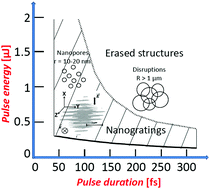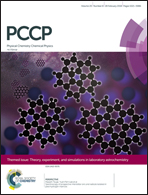Nanopore-mediated ultrashort laser-induced formation and erasure of volume nanogratings in glass†
Abstract
Ultrashort laser nanostructuring of glasses has attracted increasing interest over the last few decades due to numerous applications in three-dimensional nanofabrication, optical data storage, and development of nanofluidic and polarization-sensitive devices. The knowledge of the influence of laser parameters on the nanostructure formation/erasure is still lacking. In this work, laser-induced modifications and mechanisms of glass decomposition in fused silica are numerically investigated. Cavitation is shown to be the primary mechanism responsible for void formation at the center of the heat-affected zone. Multipulse accumulation processes providing higher local temperatures/pressures lead to the rapid formation of cavitation nanopores, lying in the origin of self-organized nanogratings. Femtosecond laser-interaction threshold conditions required for nanograting formation/erasure are defined in agreement with the available experimental findings. For this, a detailed multi-physical modeling is performed taking into account laser pulse propagation in nonlinear and dispersive media, electronic relaxation/excitation processes, electron–ion heat transfer and thermal diffusion. Based on the calculated temperatures, classical nucleation theory, viscoelastic energy conservation law and the Rayleigh–Plesset model, threshold conditions leading to nanopore formation, stability and growth are investigated as a function of laser energy, pulse duration and repetition rate. The performed numerical study not only contributes to a better fundamental understanding of ultrashort laser-induced modifications on the nanoscale but should also be helpful in defining the optimal laser parameters for nanostructuring or avoiding nanostructure organization and in developing techniques for nanograting rewriting.



 Please wait while we load your content...
Please wait while we load your content...